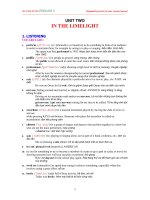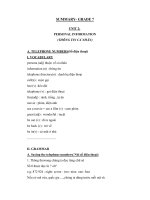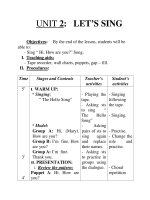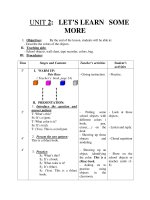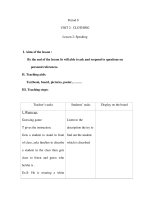Unit 2 plants (Ielts)
Bạn đang xem bản rút gọn của tài liệu. Xem và tải ngay bản đầy đủ của tài liệu tại đây (34.16 KB, 7 trang )
IELTS READING
Unit 2: Plants
Vocabulary:
•
•
•
•
•
•
•
•
•
•
Tensile strength (n): cường độ chịu kéo
Habitat (n): mơi trường sống
Commodity (n): hàng hố
Evergreen (n,a): cây xanh quanh năm,
xanh quanh năm
Endosperm (n): nội nhũ
Derivative (n): sự bắt nguồn
Foliage (n): tán lá
Palm tree (n): cây cọ
Seed (n): hạt giống
Cosmetic (n): mỹ phẩm
Practice:
Passage 1:
Bamboo is a type of grass. It comes in a
wide variety of forms, ranging in height
from 30 centimeters to more than 40
meters. It is also the world’s fastest-growing
woody plant; some species can grow more
than a meter in a day. Bamboo’s ecological
role extends beyond providing food and
habitat for animals. Bamboo tends to grow
in stands made up of groups of individuals
plants that grow from root systems knows
as rhizomes. Its extensive rhizome systems,
which tie in the top layers of the soil, are
crucial in preventing soil erosion.
However, bamboo’s not most immediate
significance lies in its economic. Modern
processing techniques mean that it can be
used in a variety of ways, for example, as
flooring and laminates. One of the fastest
growing bamboo products is paper -25
percent of paper produced in India is made
from bamboo fiber, and in Brazil, 100,000
hectares of bamboo are grown for its
production. Of course, bamboo’s main
function has always been in domestic
application, and as a locally traded
commodity it’s worth about $4.5 billion
annually. Because of its versatility, flexibility
and strength (its tensile strength compares
to that of some steel), it has traditionally
been used in construction. Today, more than
one billion people worldwide live in bamboo
houses.
Questions 1 – 4
Answer the questions below using NO
MORE THAN TWO WORDS from the
passage for each answer.
1.
2.
Two benefits that bamboo brings to
animals are …………….. and ………………
The unique root system of bamboo
prevents ………………
3.
4.
…………….., which is a bamboo product, is
experiencing market expansion.
Bamboo has a traditional function in
………………
Passage 2:
Coconut palms produce as many as seventy
fruits per year, weighing more than a
kilogram each. The wall of the fruit has
three layers: a waterproof outer player, a
fibrous middle layer and a hard, inner layer.
The thick fibrous middle layer produces
coconut fibre, ‘coir’, which has numeroud
uses and is particularly important in
manufacturing ropes. The woody innermost
layer, the shell, with its three prominent
‘eyes’, surround the seed. An important
product obtained from the shell is charcoal,
which is widely used in variois industries as
well as in the home as a cooking fuel. When
broken in half, the shells are also used as
bowls in many parts of Asia.
Inside the shell are the nutrients
(endosperm) needed by the developing
seed. Initially, the endosperm is a sweetish
liquid, coconut water, which is enjoyed as a
drink, but also provides the hormones
which encourage other plants to grow more
rapidly and produce higher yields. As the
fruit matures, the coconut water gradually
solidifies to form the brilliant white, fat-rich,
edible flesh or meat. Dried coconut flesh,
‘copra’, is made into coconut oil and coconut
milk, which are widely used in cookung in
different parts of the world, as well as in
cosmetics. A derivative of coconut fat,
glycerine, acquired strategic importance in a
quite different sphere, as Aflred Nobel
introduced the world to his nitroglycerinebased invention: dynamite.
Questions 1 – 6
Complete the table below
Choose ONE WORD ONLY from the passage
for each answer.
THE COCONUT FRUITS
Description
Outer layer
Middle layer (coir fibres)
Inner layer (shell)
Coconut water
Coconut flesh
Answers:
Passage 1:
1.
2.
Food, habitat
Soil erosion
3.
4.
Paper
Construction
Passage 2:
1.
2.
3.
4.
5.
6.
Ropes
Charcoal
Bowls
Hormones
Cosmetics
Dynamite

